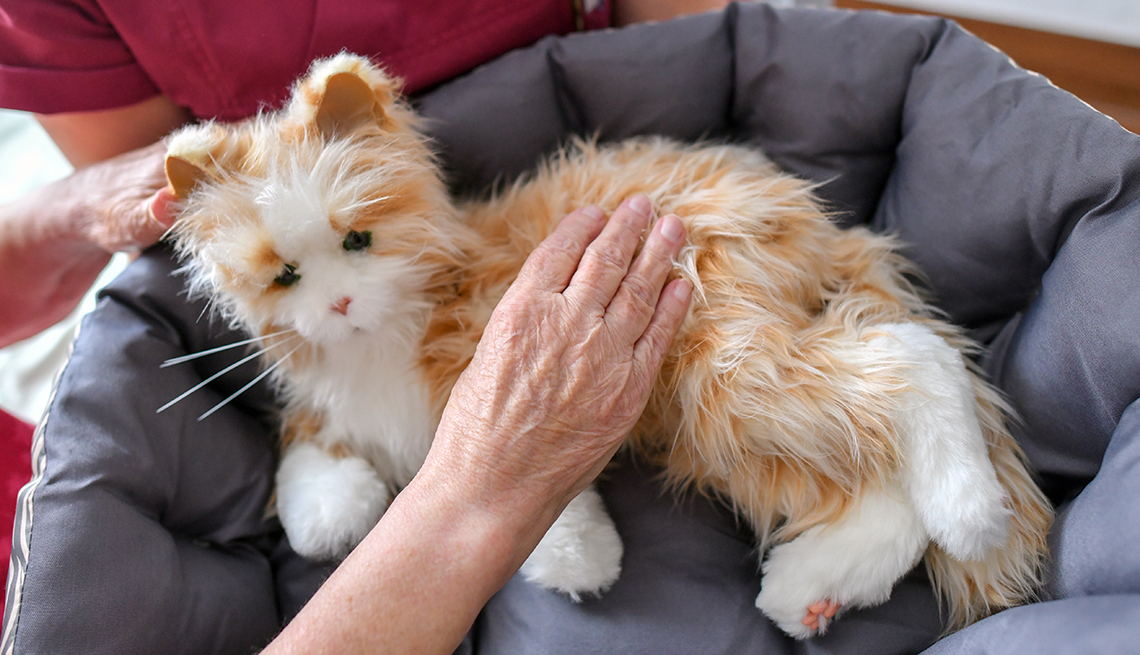
- Select a language for the TTS:
- UK English Female
- UK English Male
- US English Female
- US English Male
- Australian Female
- Australian Male
- Language selected: (auto detect) - EN
Play all audios:
Other organizations have found comparable success. The U.S. Department of Veterans Affairs (VA) began using robotic pets during the COVID-19 pandemic. In North Carolina, robotic pets at the
Salisbury VA Community Living Center “have brought comfort, connection and therapeutic benefits to veterans with memory loss, dementia and depression,” the VA reported in 2022. “Patients
tend to calm down when they have someone or something to nurture.” Numerous studies support the benefits. The University of Plymouth conducted an eight-month study before and during the
COVID pandemic at eight care facilities in Cornwall, England, and released the findings in September 2022: Residents with mechanical pets showed “decreased neuropsychiatric symptoms,”
including delusions and depression, compared with those who didn’t have robotic animals. A 2022 study published in the _Journal of Holistic Nursing_ observed similar results. In a six-week
study involving 18 men and women with dementia in a residential care facility in the Northeastern U.S., it was reported that loneliness was “significantly reduced” and there was a
“significant improvement” in depression after participants interacted with the robotic cats and dogs. Companion animals might even provide mental stimulation. In a 2021 study from Florida
Atlantic University, dementia patients with robotic cats showed improved moods — several caregivers noted that their loved ones often slept with the cats — and more than 50 percent showed
slight to moderate improvement in areas such as attention and language (researchers found that participants frequently talked to their pets). Mechanical animals can also help residents
engage in reminiscence therapy — which involves using prompts such as photos and music to stir memories and conversation — by evoking recollections of their childhood pets, a report from the
VA states. Although she is nonverbal, resident Iris Pierce sings and hums to the animatronic dog; Veteran Gerardo Sotelo loves holding the robotic animals because “they are so soft and
even move around just like a real animal.” Courtesy Ambrosio Guillen Texas State Veterans Home Thinking about buying a robotic pet for a loved one? A company called Ageless Innovation
manufactures the companion animals used by Capital Caring and other organizations. You can expect to pay $100-$140 for a dog, $125-$140 for a cat and around $47 for a bird on major retail
sites. Similar products include MetaCat ($189), a robotic cat that makes realistic motions and sounds, and Perfect Petzzz ($40), synthetically furred cats and dogs that “breathe” with the
aid of a battery. Another option: Contact your state or county agency on aging — some distribute the animals for free to residents. In Washington, for example, senior services agencies
throughout the state have distributed more than 700 robotic dogs and cats to older people dealing with dementia or loneliness. The New York State Office for the Aging distributed about 4,000
animatronic pets during the pandemic; it plans to provide an additional 17,000 to older residents through local agencies in the coming years. Although the pets can help ease loneliness and
anxiety, they are not a four-legged panacea, particularly for those with dementia, warns Monica Moreno, senior director of care and support at the Alzheimer’s Association. Some people may
respond positively to the animals, some won’t. To improve the odds of success, it helps to understand an individual’s background. “It's about connecting with the person where they’re
at, trying to see the world through their eyes and understanding what they are feeling, and then identifying the best approach to provide comfort,” Moreno says. “That intervention may be a
robotic pet. But you have to know the person and their history and their likes and dislikes.” An example: If someone had a bad experience with a dog when they were young or they’ve had a
lifelong fear of animals, giving them a robotic dog could backfire. “Instead of calming them and providing them with comfort, it may cause them to become more anxious and more upset,” Moreno
says. Conversely, some dementia patients may become too attached to their robotic Fido, and if it gets lost, it may cause anxiety.








